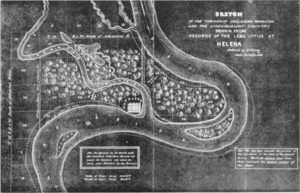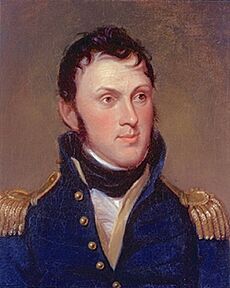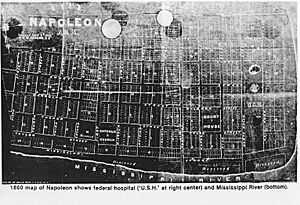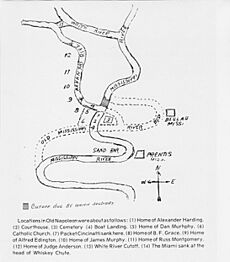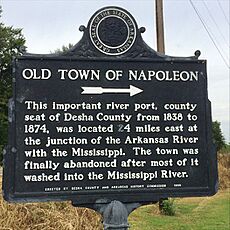Napoleon, Arkansas facts for kids
Quick facts for kids Napoleon, Arkansas |
|
|---|---|

Napoleon from the northern bank of the Arkansas
|
|
| Location | Desha County, Arkansas |
| Founder | Frederick Notrebe |
| Lua error in Module:Location_map at line 420: attempt to index field 'wikibase' (a nil value). | |
Napoleon was an important river port town in Arkansas. It was the main town of Desha County from 1838 to 1874. The town was located right where the Arkansas River met the mighty Mississippi River. Napoleon faced a lot of damage during the Civil War. Later, most of the town was washed away by the Mississippi River, leading to its abandonment.
Contents
History of Napoleon
How Napoleon Started
Napoleon was founded by Frederick Notrebe. He named the town after "his old commander." It was built on the west bank where the Arkansas River flowed into the Mississippi. This spot was a very busy pathway along the Mississippi River. However, the area often flooded because of the powerful Arkansas and Mississippi rivers.
We don't know the exact date Napoleon was founded. A post office opened there in 1832. A school started on December 10, 1838. A Catholic church was also established in May 1839.
The leaders of Napoleon had big plans. They built a large dock for boats. They also wanted a special hospital for sailors to be built there. They even dreamed of building a railroad from Napoleon all the way to the Pacific Ocean!
Despite these big dreams, the town quickly got a bad reputation. People said it was dirty, full of bugs, and had a lot of crime. In 1851, a U.S. Supreme Court Justice named Peter Vivian Daniel visited. He called Napoleon a "miserable place." He said it had "a few slightly built wood houses" that were falling apart.
By 1852, a town called Wellington was built across the Mississippi River in Mississippi. This created a friendly competition between the two towns for river trade. From 1850 to 1860, Napoleon's population almost doubled. The Marine Hospital became the most important building in town. Even with more people, floods were a big problem. People talked about building levees (walls to hold back water), but few were actually built.
The Marine Hospital Story
In 1837, the U.S. Congress decided to build seven Marine Hospitals. These hospitals cared for sick or injured sailors. Napoleon was chosen as one of the locations in 1842. Major Stephen Harriman Long was put in charge of building the hospital in Napoleon in 1849.
Major Long quickly saw the flooding problems in Napoleon. He wrote that the chosen spot for the hospital was "objectionable." He wanted the hospital to be built on higher ground in Helena, Arkansas. But his concerns were ignored. Congress wanted the hospital built in Napoleon without delay.
Construction began in August 1850. Flooding and sickness caused many delays. The work was very slow for three years. Finally, in August 1854, the hospital was finished. It started taking patients in 1855.
Major Long's worries were correct. By March 1868, the river had eaten away the land. The hospital was only 52 feet from the water! Less than a month later, a corner of the hospital fell into the river. A newspaper reported that "about one half broken off and caved into the river." The hospital slowly crumbled into the water. The entire town of Napoleon would be swallowed by the river just 25 years after Major Long first warned about the location.
Napoleon During the Civil War
On February 12, 1861, before Arkansas left the Union, the governor ordered the Marine Hospital and ammunition shipments to be taken over. In April 1861, people who supported leaving the Union set up cannons at Napoleon. They wanted to stop riverboats for inspection.
By September 1862, the Union army took control of Napoleon. The Union Navy controlled the rivers. The once busy port became almost empty. The economy was ruined. Slavery was ending. All river traffic was controlled by the Union. During the winter of 1863, the town was largely stripped for firewood. The Catholic church had its benches torn apart. The only building still standing was the Marine Hospital. But the Union forces did not use it as a hospital.
Even after the Union won battles nearby, like the Battle of Saint Charles in 1862, rebels kept attacking Union ships. After one attack in 1863, a Union gunship led by William Tecumseh Sherman landed at Wellington and burned it down.
Geography and the River's Change
The river that helped Napoleon grow also led to its end. On April 14, 1863, Union Commander Thomas Oliver Selfridge was patrolling near Napoleon. He was angry that rebels kept firing at Union ships from a place called Beulah Bend. His boss, David Porter, called it "one of the worst points for guerrillas."
East of Napoleon, Beulah Bend was a 10-mile curve in the Mississippi River. It started near the mouth of the Arkansas River and circled back close to it. During the American Civil War, Confederate soldiers would hide in the woods near the bend. They would fire at Union ships passing by. The bend was so tight that rebels could fire at a ship, then quickly move their cannons a short distance to fire at the same ship again as it came around the bend.
Commander Selfridge had an idea. He wanted to dig a canal to make the river bypass Beulah Bend. He saw that floodwaters made the distance short enough. A similar idea had failed at the Siege of Vicksburg. But Selfridge put his men to work digging a canal only a few hundred yards long. It worked quickly! In just one day, the water cut a raging path through the earth, carrying even large trees. The next morning, Selfridge sailed his ship, the Conestonga, through the new canal at full speed. He estimated the current was 12 knots (about 14 miles per hour).
Admiral Porter was very impressed. He wrote to the Secretary of the Navy on April 16, 1863. He said the canal showed "how easily cut-offs are made in the Mississippi." He explained that the canal saved over 10 miles of travel. It also brought the mouths of the Arkansas and White rivers closer together. This made it easier for a small force to defend both. It also got rid of "one of the worst points for guerrillas."
Napoleon's End
Even though the canal helped river traffic, it sped up Napoleon's end. The Mississippi River's water quickly started eroding the town's banks. Ten years after the canal was dug, the town would be gone. After the war, Napoleon was almost a ghost town.
Some families did return, but most did not. A newspaper in Napoleon, The Napoleon News, came back in 1870. It even claimed that silver had been found near the town.
Many people hoped the town would become prosperous again. But Napoleon never had a silver boom. Floods continued. The Mississippi River cut into the town, separating one side from the other. Thieves even used a flat boat to steal a safe from the county clerk's office! The safe had no money, but it held important town records.
Today, the Catholic Church bell from Napoleon is in McGehee. All that is left of Napoleon are a few ruins. You can only see them when the river water is very low.
About Frederick Notrebe
Frederick Notrebe was a former French soldier. He moved to Arkansas Post in the summer of 1810. Notrebe was born in France in 1780. He first came to Arkansas Post as an agent for a businessman from New Orleans. In 1811, Notrebe bought a house and land in Arkansas. That same year, he married Mary Felicite Bellette. They had five children. Only one son, Eugene, carried on the Notrebe name. Eugene's son was named Napoleon Bonaparte Notrebe.
Notrebe was often called "Colonel." We don't know much about his military service in France. But his close friend, Antoine Barraqué, fought under Napoleon Bonaparte in several famous battles. Notrebe's title of Colonel was probably an honorary one. He was part of the local militia before Arkansas became a territory in 1819. In 1820, he became a "Common Pleas Judge" for the area.
Notrebe built a trading house and store at Arkansas Post. He first traded furs with the local Quapaw tribe. Later, he bought enough land to start a plantation. By 1819, he began trading cotton. The local economy shifted from furs to cotton. With the invention of the cotton gin, Notrebe built one in 1827. His focus became entirely agricultural. By 1836, Notrebe owned 3,496 acres of land. His son-in-law owned even more. With 71 slaves working on his plantations, Notrebe was a very important person in the area.
Notrebe died while on a business trip in New Orleans on April 13, 1849.
Napoleon in Popular Culture
The town of Napoleon was featured in Mark Twain's book Life on the Mississippi. In the book, Twain tells a story about a deathbed confession. Someone said $10,000 was hidden behind a brick in a building in Napoleon. When Twain tried to find it, he discovered the entire town had been washed away! Twain also wrote that early explorers like De Soto, Marquette, Joliet, and La Salle visited the future site of Napoleon, Arkansas, during their journeys.


